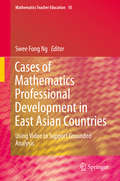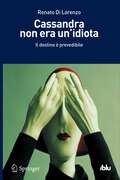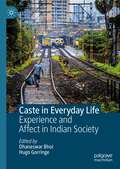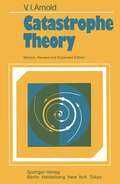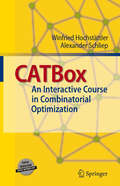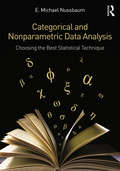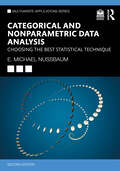- Table View
- List View
Cases of Mathematics Professional Development in East Asian Countries: Using Video to Support Grounded Analysis (Mathematics Teacher Education #10)
by Swee Fong NgThis book shows how video technology can be used to inform teachers’ personal practice, and provides new data and real-world case studies not covered by any previous book on the subject.Initial chapters explore how practicing teachers can view their own recorded lessons and take steps to improve their methods, while subsequent chapters examine how pre-service and in-service teachers can use recorded lessons to improve how they teach selected concepts, or to better convey specific learning processes such as mathematical modeling and problem solving.
Cassandra non era un'idiota: Il destino è prevedibile (I blu)
by Renato Di LorenzoEsiste una cosa chiamata destino? o è solo un mito, come quello di Cassandra?Si fa sempre un po’ fatica – ovvio – a pensare che il mito (nella fattispecie quello di Cassandra) racconti fatti realmente accaduti. Infatti non sono realmente accaduti. Ma è difficile che il mito racconti fatti totalmente impossibili. Nessuno sa perché, ma il mito verte sempre intorno ad accadimenti che un giorno magari si riveleranno un po’ veri. Non del tutto veri: solo un po’. Ma veri.E’ così del resto anche per molte verità scientifiche, presagite nel passato, e verificate in seguito usando la fisica e le altre scienze che, sviluppate, sono poi state capaci di affrontarle.Ma esiste allora una matematica del destino, qualcosa come il principio di minima azione di Hamilton, che date le condizioni iniziali di un mondo macroscopico determina in maniera univoca lo stato futuro del mondo stesso? Per quanto increduli, la risposta deve essere: sì.
Cassirer (The Routledge Philosophers)
by Samantha MatherneErnst Cassirer (1874–1945) occupies a unique place in 20th-century philosophy. His view that human beings are not rational but symbolic animals and his famous dispute with Martin Heidegger at Davos in 1929 are compelling alternatives to the deadlock between 'analytic' and 'continental' approaches to philosophy. An astonishing polymath, Cassirer's work pays equal attention to mathematics and natural science but also art, language, myth, religion, technology, and history. However, until now the importance of his work has largely been overlooked. In this outstanding introduction Samantha Matherne examines and assesses the full span of Cassirer’s work. Beginning with an overview of his life and works she covers the following important topics: Cassirer’s neo-Kantian background Philosophy of mathematics and natural science, including Cassirer’s first systematic work, Substance and Function, and subsequent works, like Einstein’s Theory of Relativity The problem of culture and the ground-breaking The Philosophy of Symbolic Forms Cassirer’s ethical and political thought and his diagnosis of fascism in The Myth of the State Cassirer’s influence and legacy. Including chapter summaries, suggestions for further reading, and a glossary of terms, this is an ideal introduction to Cassirer’s thought for anyone coming to his work for the first time. It is essential reading for students in philosophy as well as related disciplines such as intellectual history, art history, politics, and literature.
Cassirer (The Routledge Philosophers)
by Samantha MatherneErnst Cassirer (1874–1945) occupies a unique place in 20th-century philosophy. His view that human beings are not rational but symbolic animals and his famous dispute with Martin Heidegger at Davos in 1929 are compelling alternatives to the deadlock between 'analytic' and 'continental' approaches to philosophy. An astonishing polymath, Cassirer's work pays equal attention to mathematics and natural science but also art, language, myth, religion, technology, and history. However, until now the importance of his work has largely been overlooked. In this outstanding introduction Samantha Matherne examines and assesses the full span of Cassirer’s work. Beginning with an overview of his life and works she covers the following important topics: Cassirer’s neo-Kantian background Philosophy of mathematics and natural science, including Cassirer’s first systematic work, Substance and Function, and subsequent works, like Einstein’s Theory of Relativity The problem of culture and the ground-breaking The Philosophy of Symbolic Forms Cassirer’s ethical and political thought and his diagnosis of fascism in The Myth of the State Cassirer’s influence and legacy. Including chapter summaries, suggestions for further reading, and a glossary of terms, this is an ideal introduction to Cassirer’s thought for anyone coming to his work for the first time. It is essential reading for students in philosophy as well as related disciplines such as intellectual history, art history, politics, and literature.
Casson's Invariant for Oriented Homology Three-Spheres: An Exposition. (MN-36) (PDF)
by Selman Akbulut John D. MccarthyIn the spring of 1985, A. Casson announced an interesting invariant of homology 3-spheres via constructions on representation spaces. This invariant generalizes the Rohlin invariant and gives surprising corollaries in low-dimensional topology. In the fall of that same year, Selman Akbulut and John McCarthy held a seminar on this invariant. These notes grew out of that seminar. The authors have tried to remain close to Casson's original outline and proceed by giving needed details, including an exposition of Newstead's results. They have often chosen classical concrete approaches over general methods. For example, they did not attempt to give gauge theory explanations for the results of Newstead; instead they followed his original techniques.Originally published in 1990.The Princeton Legacy Library uses the latest print-on-demand technology to again make available previously out-of-print books from the distinguished backlist of Princeton University Press. These editions preserve the original texts of these important books while presenting them in durable paperback and hardcover editions. The goal of the Princeton Legacy Library is to vastly increase access to the rich scholarly heritage found in the thousands of books published by Princeton University Press since its founding in 1905.
Caste in Everyday Life: Experience and Affect in Indian Society
by Dhaneswar Bhoi Hugo GorringeThis edited volume brings together a range of scholars to reflect on the varied ways in which caste is manifested and experienced in social life. Each chapter draws on different methods and approaches but all consider lived experiences and experiential narrations. Considering Guru and Sarukkai’s path-breaking work on ‘Experience, Caste and the Everyday Social’ (2019), this volume applies the insights of the theories to multiple settings, issues and communities. Unique to this volume, Brahmin and other dominant castes' experiences are considered, rather than simply focusing on the lives of oppressed castes (Dalits). Analysis of cross-caste friendships or romances and marriages, furthermore, brings out the intimate and ingrained aspects of caste. Taken together, therefore, the contributions in this volume offer rich insights into caste and its consciousness within the framework of everyday experiences.
CAT: An Introduction (Lecture Notes in Mathematics #2324)
by Petra SchwerIn recent years cube complexes have become a cornerstone topic of geometric group theory and have proven to be a powerful tool in other areas, such as low dimensional topology, phylogenetic trees or in the context of optimization problems.This book covers a wide variety of algebraic and geometric properties of cube complexes and the groups acting on them. The content ranges from basic properties of metric spaces, notions of non-positive curvature, Gromov's link condition and the Švarc–Milnor theorem to advanced material such as the cubulation of half-space systems and the Roller boundary, the construction of cube complexes associated with Coxeter groups, and the Tits alternative for cubical groups.Being the first self-contained, comprehensive introduction to cube complexes this book serves as an entry point for researchers interested in the subject. The material is accessible to advanced undergraduate and graduate students. The text is illustrated with many figures and examples and comes with a large collection of exercises.
Cataclysmic Variables: Proceedings of the Conference held in Abano Terme, Italy, 20–24 June 1994 (Astrophysics and Space Science Library #205)
by A. Bianchini M. Della Valle M. OrioCataclysmic Variables (CVs) are well furnished laboratories in which one can investigate a number of important physical processes. These processes include: thermonuclear reactions, nebular physics, winds, mass accretion phenomena on compact objects, magnetohydrodynamics, plasmas, thermal and non thermal radiative processes, relativistic phenomena, dust forma tion, etc . . In the recent year the most exciting development in our opinion was that the small, cold and invisible secondary components of CV s were found to be the prime motors for the evolution of close binary systems, disclosing new scenarios for research. All branches of astronomy and as trophysics often take advantage of the new ideas brought by the study of CVs. It is for this reason, we believe, that meetings on CVs are important for most of the astronomical community. The idea of a Congress on CVs in Padova has been fluttering in the air for a few years. After all - we thought - a large part of the scientific heritage of Padova and Asiago Observatories is represented by the study of variable stars and, in particular, of CV s, as Prof. L. Rosino reminded us at the very beginning of the Congress. We finally chose Abano Terme as the site of the Conference, not merely because Abano is one of the most famous centers in Europe for mud therapy, and astronomers easily suffer from rheumatism, but also because we knew that a very hearty welcome from the Abano Municipality and touristic associations awaited us.
Catalan Numbers with Applications
by Thomas KoshyLike the intriguing Fibonacci and Lucas numbers, Catalan numbers are also ubiquitous. "They have the same delightful propensity for popping up unexpectedly, particularly in combinatorial problems," Martin Gardner wrote in Scientific American. "Indeed, the Catalan sequence is probably the most frequently encountered sequence that is still obscure enough to cause mathematicians lacking access to Sloane's Handbook of Integer Sequences to expend inordinate amounts of energy re-discovering formulas that were worked out long ago," he continued. As Gardner noted, many mathematicians may know the abc's of Catalan sequence, but not many are familiar with the myriad of their unexpected occurrences, applications, and properties; they crop up in chess boards, computer programming, and even train tracks. This book presents a clear and comprehensive introduction to one of the truly fascinating topics in mathematics. Catalan numbers are named after the Belgian mathematician Eugene Charles Catalan (1814-1894), who "discovered" them in 1838, though he was not the first person to discover them. The great Swiss mathematician Leonhard Euler (1707-1763) "discovered" them around 1756, but even before then and though his work was not known to the outside world, Chinese mathematician Antu Ming (1692?-1763) first discovered Catalan numbers about 1730. Catalan numbers can be used by teachers and professors to generate excitement among students for exploration and intellectual curiosity and to sharpen a variety of mathematical skills and tools, such as pattern recognition, conjecturing, proof-techniques, and problem-solving techniques. This book is not only intended for mathematicians but for a much larger audience, including high school students, math and science teachers, computer scientists, and those amateurs with a modicum of mathematical curiosity. An invaluable resource book, it contains an intriguing array of applications to computer science, abstract algebra, combinatorics, geometry, graph theory, chess, and World Series.
Catalan's Conjecture (Universitext)
by René SchoofEugène Charles Catalan made his famous conjecture – that 8 and 9 are the only two consecutive perfect powers of natural numbers – in 1844 in a letter to the editor of Crelle’s mathematical journal. One hundred and fifty-eight years later, Preda Mihailescu proved it. Catalan’s Conjecture presents this spectacular result in a way that is accessible to the advanced undergraduate. The author dissects both Mihailescu’s proof and the earlier work it made use of, taking great care to select streamlined and transparent versions of the arguments and to keep the text self-contained. Only in the proof of Thaine’s theorem is a little class field theory used; it is hoped that this application will motivate the interested reader to study the theory further. Beautifully clear and concise, this book will appeal not only to specialists in number theory but to anyone interested in seeing the application of the ideas of algebraic number theory to a famous mathematical problem.
Catastrophe Theory
by V. I. Arnol'dSingularity theory is growing very fast and many new results have been discovered since the Russian edition appeared: for instance the relation of the icosahedron to the problem of by passing a generic obstacle. The reader can find more details about this in the articles "Singularities of ray systems" and "Singularities in the calculus of variations" listed in the bi bliography of the present edition. Moscow, September 1983 v. I. Arnold Preface to the Russian Edition "Experts discuss forecasting disasters" said a New York Times report on catastrophe theory in November 1977. The London Times declared Catastrophe Theory to be the "main intellectual movement of the century" while an article on catastrophe theory in Science was headed "The emperor has no clothes". This booklet explains what catastrophe theory is about and why it arouses such controversy. It also contains non-con troversial results from the mathematical theories of singulari ties and bifurcation. The author has tried to explain the essence of the fundamen tal results and applications to readers having minimal mathe matical background but the reader is assumed to have an in quiring mind. Moscow 1981 v. I. Arnold Contents Chapter 1. Singularities, Bifurcations, and Catastrophe Theories ............... 1 Chapter 2. Whitney's Singularity Theory ... 3 Chapter 3. Applications of Whitney's Theory 7 Chapter 4. A Catastrophe Machine ...... 10 Chapter 5. Bifurcations of Equilibrium States 14 Chapter 6. Loss of Stability of Equilibrium and the Generation of Auto-Oscillations . . . . . . 20 .
Catastrophe Theory
by Vladimir I. Arnol'dThe new edition of this non-mathematical review of catastrophe theory contains updated results and many new or expanded topics including delayed loss of stability, shock waves, and interior scattering. Three new sections offer the history of singularity and its applications from da Vinci to today, a discussion of perestroika in terms of the theory of metamorphosis, and a list of 93 problems touching on most of the subject matter in the book.
Catastrophe Theory: Second Edition
by Domencio CastrigianoCatastrophe Theory was introduced in the 1960s by the renowned Fields Medal mathematician René Thom as a part of the general theory of local singularities. Since then it has found applications across many areas, including biology, economics, and chemical kinetics. By investigating the phenomena of bifurcation and chaos, Catastrophe Theory proved to
Catastrophe Theory: Second Edition
by Domencio CastrigianoCatastrophe Theory was introduced in the 1960s by the renowned Fields Medal mathematician René Thom as a part of the general theory of local singularities. Since then it has found applications across many areas, including biology, economics, and chemical kinetics. By investigating the phenomena of bifurcation and chaos, Catastrophe Theory proved to
Catastrophic Events Caused by Cosmic Objects
by Vitaly Adushkin Ivan NemchinovAn asteroid or comet will inevitably strike the Earth some day, and potentially cause great destruction. This volume considers hazards due to collisions with cosmic objects, particularly in light of recent investigations of impacts by the authors. Each chapter, written by an expert, contains an overview of an aspect and new findings in the field. Coverage describes and numerically estimates the main hazardous effects.
CATBox: An Interactive Course in Combinatorial Optimization
by Winfried Hochstättler Alexander SchliepGraph algorithms are easy to visualize and indeed there already exists a variety of packages to animate the dynamics when solving problems from graph theory. Still it can be difficult to understand the ideas behind the algorithm from the dynamic display alone. CATBox consists of a software system for animating graph algorithms and a course book which we developed simultaneously. The software system presents both the algorithm and the graph and puts the user always in control of the actual code that is executed. In the course book, intended for readers at advanced undergraduate or graduate level, computer exercises and examples replace the usual static pictures of algorithm dynamics. For this volume we have chosen solely algorithms for classical problems from combinatorial optimization, such as minimum spanning trees, shortest paths, maximum flows, minimum cost flows, weighted and unweighted matchings both for bipartite and non-bipartite graphs. Find more information at http://schliep.org/CATBox/.
Catch up Compendium, third edition: for the life and medical sciences (PDF)
by Philip Bradley Mitchell Fry Michael HarrisThis third edition of Catch up Compendiumcontains the most up-to-date editions of the three existing Catch Upbooks: Biology, Chemistryand Maths & Stats. It provides over 600 pages of background material essential for any student studying courses in the biological and biomedical sciences. The book provides a bridge between school and university courses and provides invaluable support for the fundamental concepts covered during first year university modules. Catch Up Compendiumis a unique combination: course book, revision guide, and reference source - your first year studies will be much easier with a copy by your side.
Categorical Algebra and its Applications: Proceedings of a Conference, Held in Louvain-la-Neuve, Belgium, July 26 - August 1, 1987 (Lecture Notes in Mathematics #1348)
by Francis BorceuxCategorical algebra and its applications contain several fundamental papers on general category theory, by the top specialists in the field, and many interesting papers on the applications of category theory in functional analysis, algebraic topology, algebraic geometry, general topology, ring theory, cohomology, differential geometry, group theory, mathematical logic and computer sciences. The volume contains 28 carefully selected and refereed papers, out of 96 talks delivered, and illustrates the usefulness of category theory today as a powerful tool of investigation in many other areas.
Categorical and Nonparametric Data Analysis: Choosing the Best Statistical Technique
by E. Michael NussbaumFeaturing in-depth coverage of categorical and nonparametric statistics, this book provides a conceptual framework for choosing the most appropriate type of test in various research scenarios. Class tested at the University of Nevada, the book's clear explanations of the underlying assumptions, computer simulations, and Exploring the Concept boxes help reduce reader anxiety. Problems inspired by actual studies provide meaningful illustrations of the techniques. The underlying assumptions of each test and the factors that impact validity and statistical power are reviewed so readers can explain their assumptions and how tests work in future publications. Numerous examples from psychology, education, and other social sciences demonstrate varied applications of the material. Basic statistics and probability are reviewed for those who need a refresher. Mathematical derivations are placed in optional appendices for those interested in this detailed coverage. Highlights include the following: Unique coverage of categorical and nonparametric statistics better prepares readers to select the best technique for their particular research project; however, some chapters can be omitted entirely if preferred. Step-by-step examples of each test help readers see how the material is applied in a variety of disciplines. Although the book can be used with any program, examples of how to use the tests in SPSS and Excel foster conceptual understanding. Exploring the Concept boxes integrated throughout prompt students to review key material and draw links between the concepts to deepen understanding. Problems in each chapter help readers test their understanding of the material. Emphasis on selecting tests that maximize power helps readers avoid "marginally" significant results. Website (www.routledge.com/9781138787827) features datasets for the book's examples and problems, and for the instructor, PowerPoint slides, sample syllabi, answers to the even-numbered problems, and Excel data sets for lecture purposes. Intended for individual or combined graduate or advanced undergraduate courses in categorical and nonparametric data analysis, cross-classified data analysis, advanced statistics and/or quantitative techniques taught in psychology, education, human development, sociology, political science, and other social and life sciences, the book also appeals to researchers in these disciplines. The nonparametric chapters can be deleted if preferred. Prerequisites include knowledge of t tests and ANOVA.
Categorical and Nonparametric Data Analysis: Choosing the Best Statistical Technique
by E. Michael NussbaumFeaturing in-depth coverage of categorical and nonparametric statistics, this book provides a conceptual framework for choosing the most appropriate type of test in various research scenarios. Class tested at the University of Nevada, the book's clear explanations of the underlying assumptions, computer simulations, and Exploring the Concept boxes help reduce reader anxiety. Problems inspired by actual studies provide meaningful illustrations of the techniques. The underlying assumptions of each test and the factors that impact validity and statistical power are reviewed so readers can explain their assumptions and how tests work in future publications. Numerous examples from psychology, education, and other social sciences demonstrate varied applications of the material. Basic statistics and probability are reviewed for those who need a refresher. Mathematical derivations are placed in optional appendices for those interested in this detailed coverage. Highlights include the following: Unique coverage of categorical and nonparametric statistics better prepares readers to select the best technique for their particular research project; however, some chapters can be omitted entirely if preferred. Step-by-step examples of each test help readers see how the material is applied in a variety of disciplines. Although the book can be used with any program, examples of how to use the tests in SPSS and Excel foster conceptual understanding. Exploring the Concept boxes integrated throughout prompt students to review key material and draw links between the concepts to deepen understanding. Problems in each chapter help readers test their understanding of the material. Emphasis on selecting tests that maximize power helps readers avoid "marginally" significant results. Website (www.routledge.com/9781138787827) features datasets for the book's examples and problems, and for the instructor, PowerPoint slides, sample syllabi, answers to the even-numbered problems, and Excel data sets for lecture purposes. Intended for individual or combined graduate or advanced undergraduate courses in categorical and nonparametric data analysis, cross-classified data analysis, advanced statistics and/or quantitative techniques taught in psychology, education, human development, sociology, political science, and other social and life sciences, the book also appeals to researchers in these disciplines. The nonparametric chapters can be deleted if preferred. Prerequisites include knowledge of t tests and ANOVA.
Categorical and Nonparametric Data Analysis: Choosing the Best Statistical Technique (Multivariate Applications Series)
by E. Michael NussbaumNow in its second edition, this book provides a focused, comprehensive overview of both categorical and nonparametric statistics, offering a conceptual framework for choosing the most appropriate test in various scenarios. The book’s clear explanations and Exploring the Concept boxes help reduce reader anxiety. Problems inspired by actual studies provide meaningful illustrations of these techniques. Basic statistics and probability are reviewed for those needing a refresher with mathematical derivations placed in optional appendices.Highlights include the following:• Three chapters co-authored with Edgar Brunner address modern nonparametric techniques, along with accompanying R code.• Unique coverage of both categorical and nonparametric statistics better prepares readers to select the best technique for particular research projects.• Designed to be used with most statistical packages, clear examples of how to use the tests in SPSS, R, and Excel foster conceptual understanding.• Exploring the Concept boxes integrated throughout prompt students to draw links between the concepts to deepen understanding.• Fully developed Instructor and Student Resources featuring datasets for the book's problems and a guide to R, and for the instructor PowerPoints, author's syllabus, and answers to even-numbered problems.Intended for graduate or advanced undergraduate courses in categorical and nonparametric statistics taught in psychology, education, human development, sociology, political science, and other social and life sciences.
Categorical and Nonparametric Data Analysis: Choosing the Best Statistical Technique (Multivariate Applications Series)
by E. Michael NussbaumNow in its second edition, this book provides a focused, comprehensive overview of both categorical and nonparametric statistics, offering a conceptual framework for choosing the most appropriate test in various scenarios. The book’s clear explanations and Exploring the Concept boxes help reduce reader anxiety. Problems inspired by actual studies provide meaningful illustrations of these techniques. Basic statistics and probability are reviewed for those needing a refresher with mathematical derivations placed in optional appendices.Highlights include the following:• Three chapters co-authored with Edgar Brunner address modern nonparametric techniques, along with accompanying R code.• Unique coverage of both categorical and nonparametric statistics better prepares readers to select the best technique for particular research projects.• Designed to be used with most statistical packages, clear examples of how to use the tests in SPSS, R, and Excel foster conceptual understanding.• Exploring the Concept boxes integrated throughout prompt students to draw links between the concepts to deepen understanding.• Fully developed Instructor and Student Resources featuring datasets for the book's problems and a guide to R, and for the instructor PowerPoints, author's syllabus, and answers to even-numbered problems.Intended for graduate or advanced undergraduate courses in categorical and nonparametric statistics taught in psychology, education, human development, sociology, political science, and other social and life sciences.
Categorical Aspects of Topology and Analysis: Proceedings of an International Conference Held at Carleton University, Ottawa, August 11-15, 1981 (Lecture Notes in Mathematics #915)
by B. BanaschewskiCategorical Closure Operators (Mathematics: Theory & Applications)
by Gabriele CastelliniThis book presents the general theory of categorical closure operators to gether with a number of examples, mostly drawn from topology and alge bra, which illustrate the general concepts in several concrete situations. It is aimed mainly at researchers and graduate students in the area of cate gorical topology, and to those interested in categorical methods applied to the most common concrete categories. Categorical Closure Operators is self-contained and can be considered as a graduate level textbook for topics courses in algebra, topology or category theory. The reader is expected to have some basic knowledge of algebra, topology and category theory, however, all categorical concepts that are recurrent are included in Chapter 2. Moreover, Chapter 1 contains all the needed results about Galois connections, and Chapter 3 presents the the ory of factorization structures for sinks. These factorizations not only are essential for the theory developed in this book, but details about them can not be found anywhere else, since all the results about these factorizations are usually treated as the duals of the theory of factorization structures for sources. Here, those hard-to-find details are provided. Throughout the book I have kept the number of assumptions to a min imum, even though this implies that different chapters may use different hypotheses. Normally, the hypotheses in use are specified at the beginning of each chapter and they also apply to the exercise set of that chapter.
